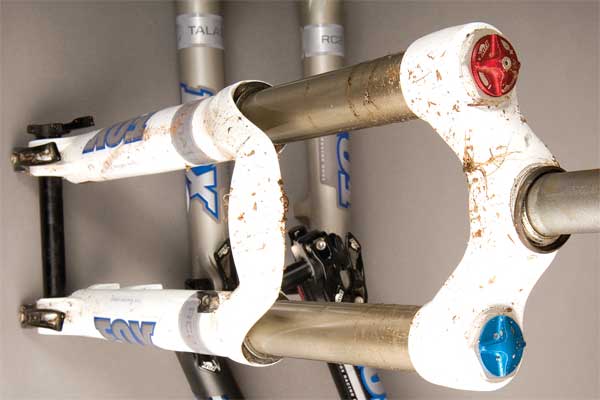
Hammered: MANITOU DORADO
There may have been a half decade time gap between version two and this latest incarnation of the Dorado, but there’s no doubting for one second that this fork is still very much a true Dorado. Visually, with its upside down design and huge carbon upper legs, it looks remarkably similar to the forks of old, but as you’d expect with any next generation product there have been numerous changes, which in the case of these forks are almost entirely internal.
Taking care of the spring duties is a new ‘self-equilibrating’ dual air chamber, which is housed inside the left hand leg. In simple speak, the fork has separate positive and negative air chambers, but rather than adjusting the pressure in each independently you just fill the forks and then they automatically balance out. It’s not quite as simple as that though, you still have two air valves; one at the top which you use to put air in, and then one at the bottom which you use to let air out. As long as you remember which does what though it’s still pretty simple, and of course the use of air as a spring allows you to get the spring rate absolutely dialled…plus it helps keep the weight down to a competitive 2885g (6lb 5.7oz).

Inside the other leg you’ll find Manitou’s TPC+ damping system, complete with its independent rebound and compression pistons, a design which Manitou have used with great success for what seems like an eternity now. The ‘+’ bit in the name refers to the extra floating speed sensitive compression stage which only really kicks in once you’ve used up the first 100mm of the fork’s 203mm of travel (the forks can also easily be adjusted down to 180mm if you really want to), or once you’ve got the forks moving beyond a certain speed. You get the ability to adjust all this trickery thanks to three dials; one on the top for rebound, and then two on the bottom for compression. The outer compression dial deals with high speed adjustment in the first 100mm of travel, and then the central dial (which controls the ‘+’ part) deals with both the slow speed stuff in that first 100mm, and high speed movement between 100mm and 160mm of travel. Past that point the forks hydraulic bottom–out starts to kick in, and this is the only part of the damping which isn’t adjustable (without serious internal tinkering).
Because the damping system is an open bath design it can, like any other open bath fork, suffer from air getting into the system if the bike is left lying down or placed upside down. It’s easy to sort out though as to bleed the system all you have to do is whack the rebound adjuster fully on and then keep compressing the forks until they rebound slowly all the way through the travel.
The only other things you really need to know from a tech point of view about these forks is that they still feature Manitou’s exclusive HexLock 20mm axle which goes some way to making up for the lack of brake arch when it comes to the forks stiffness, and that included in the price are two free services and both long and short drop crowns. At just under £2400 does that then make them a bargain? I’m not so sure.
Ed H
 [series]
[series]



